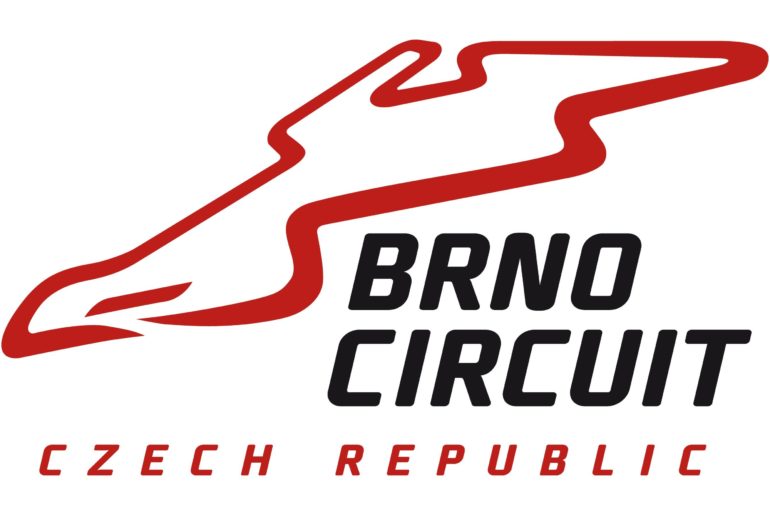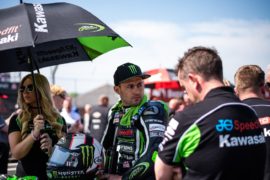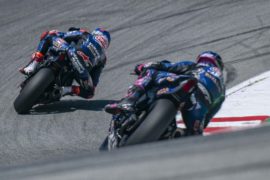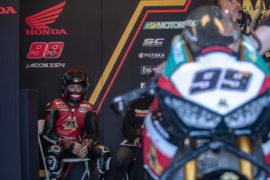The rolling hills of Brno have produced one of the most iconic circuits on the MotoGP and WorldSBK calendar, and this 5km circuit has been the home of some classic races. What goes into a fast lap though is a lot of work on your bike settings and not forcing the issue.
Max Biaggi and Marco Melandri, two former 250GP champions, have been hugely successful at the Czech track, and it’s no coincidence that both riders were schooled riding bikes that needed high corner speed.
Former MotoGP rider Michael Laverty is in Brno this weekend, and he sat down with us to talk about what goes into finding speed at the track, and what he’s seen from watching trackside on Friday.
“I really enjoy Brno, but it’s a track that you can’t attack,” said Laverty. “This is a track where you need to let it come to you and your settings are crucial. You can’t force the bike around here because it needs to turn naturally for you.”
“That’s the reason that Max Biaggi was the king here for so long, because he let the bike do the work. Max didn’t brake late into the corners and he didn’t force the bike to turn in the mid-corner, and on the exit he wasn’t sliding once he got on the gas. He was just smooth and relaxed and that’s the key.”
“With your setting you need to find a compromise, and the trail of the bike is the biggest factor here. If you increase your trail, the bike exits the corner well, but if you decrease it, you enter the corner better.”
“It’s tricky to find the sweet spot here, where you’re not losing out on either phase, and that’s why the geometry of the bike is key. This weekend the temperature has made it quite slick here, and riders are having to go a bit softer with their settings to try and find some rear grip.”
“Brno is typically a very high-grip track, you could see that in the rain where riders were committing very aggressively to turning in, but it’s greasy this weekend for some reason. The grip drops away here after a few laps, but then stays very consistent.”
“You can get a couple of fast laps out of a tire, but then the grip drops and you lose some time. It’s a high-grip track, but you can’t drag a lap time out of the bikes, and you really need to let it come to you through the bike settings.”
From standing trackside Laverty was able to see the difference between riders, and he was surprised that Friday pace-setter Jonathan Rea was able to ride so aggressively.
The Kawasaki is clearly very sorted for Rea, but the grip that he enjoys has allowed him to take a different approach to the normal service at Brno.
“Johnny rides the Kawasaki very differently to everyone else. He’s very aggressive on the bike compared to others here, and whereas you typically need to carry the corner speed and be smooth, here with Johnny he’s attacking the corner and making a ‘V’ out of each section.”
“It’s different to the rest, and when he has grip he’s fantastic, but when you use the rear tire to turn the bike it can be difficult to keep doing that when the grip drops. Using the rear to hook the bike puts a lot of strain on the rear tire, but usually Johnny and Pere Riba are on top of that.”
“From watching trackside, there’s some riders who are being aggressive with the rear, but they don’t have the grip from the rear tire.”
“It’ll be interesting to see what changes on Saturday because a lot of teams were trying to manage their problems with the electronics and for some bikes, Ducati for example, it’s very aggressive when their electronics cut off the power because they only have two cylinders.”
“If you have more cylinders you can control the pulses better without upsetting the bike as much. Watching Ducati, they were suffering from a lot of electronic intrusion whereas Kawasaki could manage it better.”
“Johnny was the only rider attacking the corners from the start, whereas everyone else was trying to carry rolling speed through the turns, but that changed as the day went on.”
The 5.4km layout features a series of “S bends” that characterize the track, and as a very wide circuit, it offers plenty of variety for lines and riders can attack one another.
For Laverty, one of the keys to the weekend will be that Kawasaki and Rea seem to be able to use the low-end torque of their engine to pull the bike out of the second gear corners better than their rivals.
“Most bikes, only Johnny and the Yamaha’s didn’t, are in second and third gear through the stadium. Johnny can comfortably hold second all the way through here and still has enough torque to pull out of the corners.”
“This section was always taken in second for everyone, but the new rev limits have clearly changed that. You exit the stadium, and you’re up to fifth down the hill before coming back to second again for the right-hander.”
“The rev limits have changed some of the character here, because there are some corners where the bike will be a little lazy because you set your gearing for the straights and the big tire also is affecting this.”
“The gearing is a bigger compromise here compared to in the past, so you need to have that torque in the low revs, and that seems to be a big advantage for Kawasaki at the moment.”
Whether that advantage holds for Saturday remains to be seen, but the tire life is sure to be crucial this weekend. Brno isn’t offering the same grip as usual, and being able to make the tire work for the race distance will be key.
This World Superbike story is made possible by our A&R Pro members. If you like reading WorldSBK stories on Asphalt & Rubber, you should consider supporting this content by signing up for A&R Pro.





